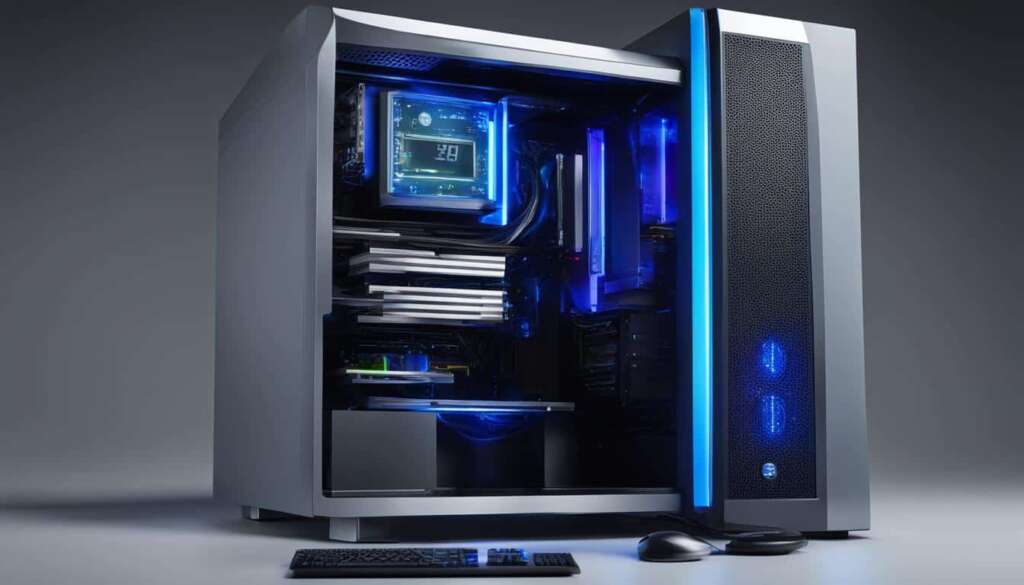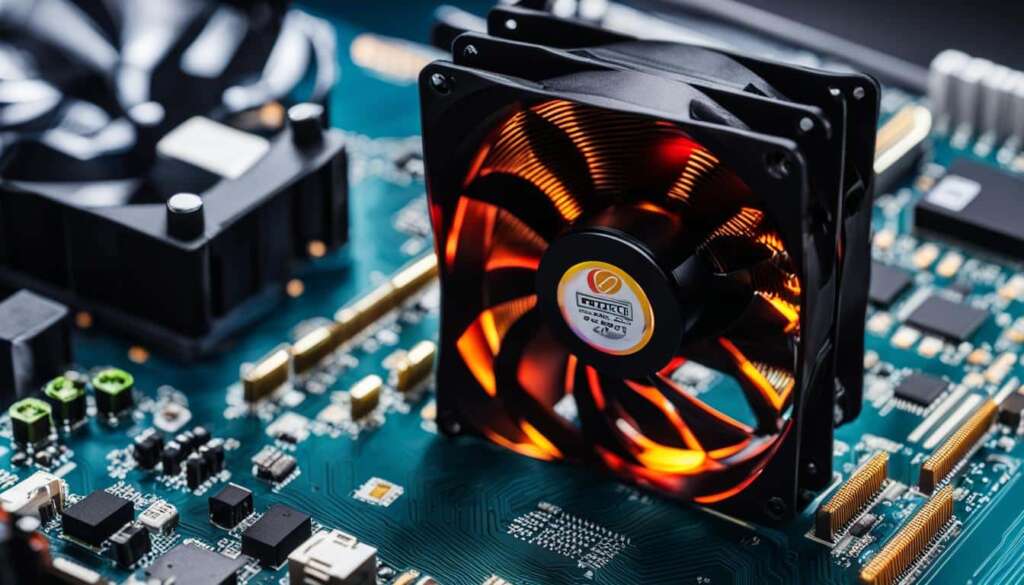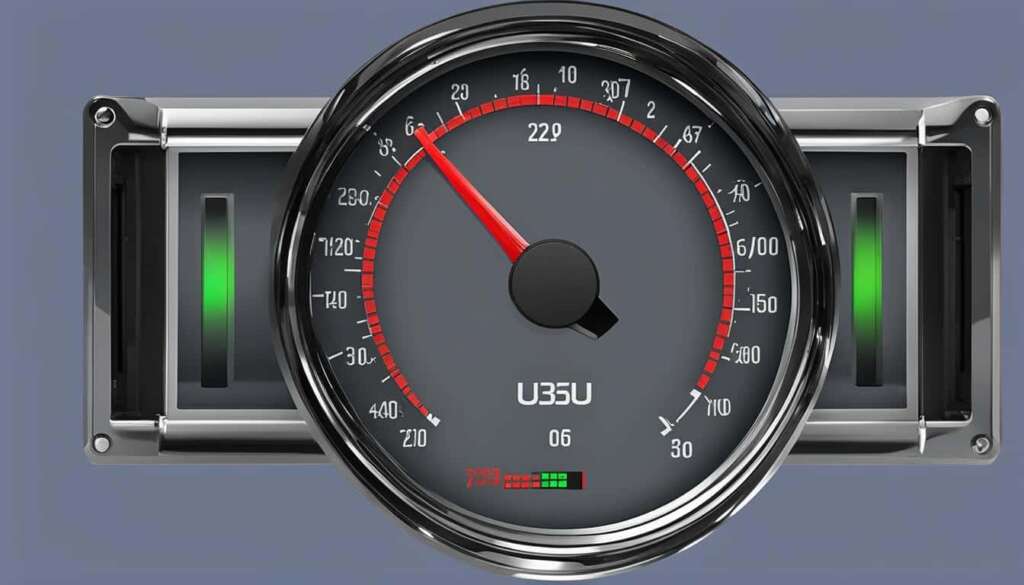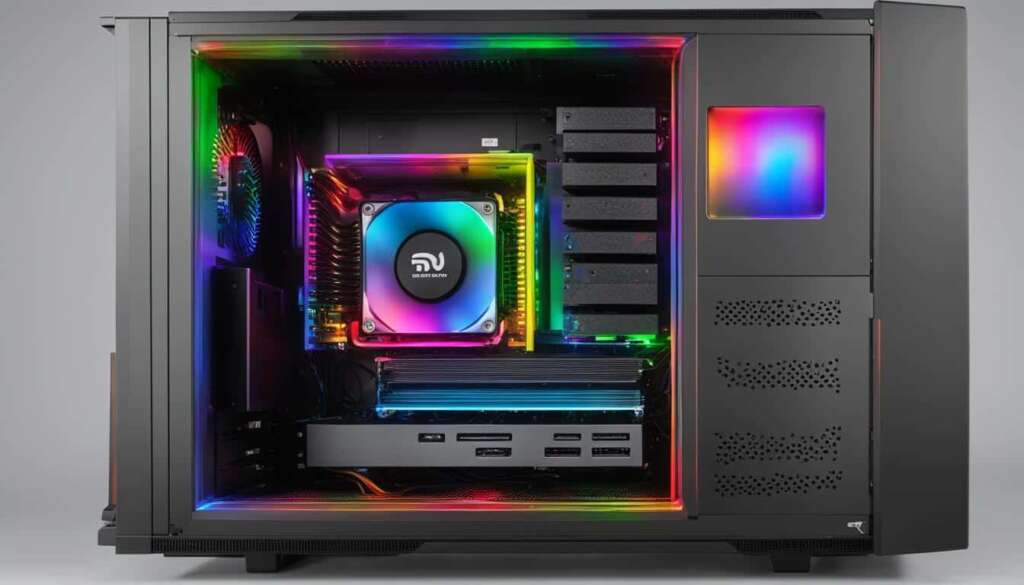Table of Contents
Checking your CPU temperature is crucial for maintaining optimal system performance and preventing overheating. By monitoring the temperature, you can ensure that your CPU operates within safe limits and avoid potential hardware damage. In this guide, we will show you how to check CPU temp in Windows 10 using various software tools.
Key Takeaways:
- Regularly monitoring your CPU temperature is important for maintaining system performance and preventing overheating.
- High CPU temperatures can lead to performance issues, system instability, and potential hardware damage.
- Software tools like Core Temp, NZXT’s CAM, and HWiNFO provide real-time temperature readings and help you track CPU temperature.
- You can also check CPU temperature in the BIOS/UEFI settings of your computer, although it may not accurately represent the temperature under load.
- Consult your CPU manufacturer’s specifications to determine the safe temperature range for your specific CPU model.
Why is Monitoring CPU Temperature Important?
Monitoring your CPU temperature is crucial for maintaining optimal system performance and preventing overheating. High CPU temperatures can lead to performance issues and system instability, negatively impacting your overall user experience. When a CPU operates at high temperatures, it can cause the system to become slow and unresponsive. This throttling effect reduces the CPU’s performance capabilities and can impede the smooth functioning of resource-intensive tasks such as gaming, video editing, and graphic design.
Furthermore, overheating can shorten the lifespan of your CPU and other components, leading to potential hardware failure. Excessive heat can affect the stability and reliability of the processor, causing irreversible damage and costly repairs. By regularly monitoring your CPU temperature, you can identify potential cooling issues early on and take proactive steps to prevent overheating.
“Monitoring your CPU temperature is crucial for maintaining optimal system performance and preventing overheating.”
Effective temperature monitoring allows you to optimize your system’s cooling capabilities. By monitoring CPU temperature, you can:
- Identify cooling system inefficiencies or failures
- Monitor the effectiveness of thermal paste application
- Ensure that fans are functioning optimally
- Detect and resolve any airflow obstructions
Optimizing system performance
Monitoring CPU temperature is an essential part of optimizing overall system performance. By keeping your CPU within a safe temperature range, you can ensure that it operates efficiently and at its maximum potential. When a CPU becomes overheated, it may automatically reduce its clock speed and performance to prevent damage. This thermal throttling can significantly impact the speed and responsiveness of your system, causing frustrating delays and sluggish performance.
Preventing overheating and potential damage
Regularly checking your CPU temperature enables you to detect and address any potential cooling issues before they escalate. Overheating can cause irreversible damage to your CPU, graphics card, and other vital components, leading to system instability and failure. By monitoring CPU temperature, you can take necessary measures such as reapplying thermal paste, cleaning or replacing fans, or improving overall system ventilation.
By monitoring and maintaining a safe CPU temperature, you can optimize system performance, prevent overheating, and extend the lifespan of your hardware.
| Importance of Monitoring CPU Temperature | Benefits |
|---|---|
| Preventing overheating | • Optimal system performance • Avoid CPU throttling • Longevity of CPU and components |
| Optimizing system performance | • Ensure CPU operates efficiently • Avoid performance slowdowns • Enhance user experience |
| Identifying cooling system issues | • Detect fan failures • Address thermal paste issues • Resolve airflow obstructions |
How to Check CPU Temperature Using Core Temp
Core Temp is a popular software tool for monitoring CPU temperature in Windows 10. It provides real-time temperature readings for each CPU core, allowing you to track the temperature fluctuations and identify any abnormal spikes.
To check CPU temperature using Core Temp, follow these steps:
- Download and install Core Temp from the official website.
- Launch Core Temp and you will see a dashboard displaying the temperature readings for each core.
- Monitor the temperature values and ensure that they stay within the safe range for your CPU model.
| Features | Core Temp |
|---|---|
| Real-time temperature monitoring | ✓ |
| Individual core temperature readings | ✓ |
| Safe temperature range indicator | ✓ |
| Customizable temperature alerts | ✓ |
| Supports a wide range of CPU models | ✓ |
Checking CPU Temperature with NZXT’s CAM
NZXT’s CAM is a powerful yet user-friendly software tool that allows you to monitor and manage the temperature of your CPU in Windows 10. With its intuitive interface and comprehensive features, NZXT’s CAM offers a seamless experience for users looking to keep a close eye on their CPU’s temperature.
When using NZXT’s CAM, you can gain access to detailed information about your CPU, including load, temperature, clock speed, and fan speed. This valuable data enables you to understand how your CPU is performing and identify any potential issues related to cooling or system stability.
To check your CPU temperature using NZXT’s CAM, simply follow these steps:
- Download and install NZXT’s CAM: Visit the official NZXT website to download and install the CAM software. Ensure that you download the version compatible with your Windows 10 operating system.
- Launch the CAM software: Once you have installed NZXT’s CAM, launch the software on your computer. You will be greeted with a user-friendly interface that provides a wealth of information about your CPU.
- Navigate to the PC Monitoring section: Within the CAM interface, locate and click on the “PC Monitoring” section. This section will provide you with real-time data about your CPU’s temperature and other performance metrics.
- Check the CPU temperature: On the PC Monitoring page, look for the CPU temperature displayed on the interface. Take note of the temperature reading and ensure that it remains within the safe temperature range for your specific CPU model.
With NZXT’s CAM, you can effectively monitor your CPU temperature and make informed decisions to optimize the performance and lifespan of your CPU. Regularly checking your CPU temperature is a proactive measure that can prevent overheating and potential hardware damage in the long run.
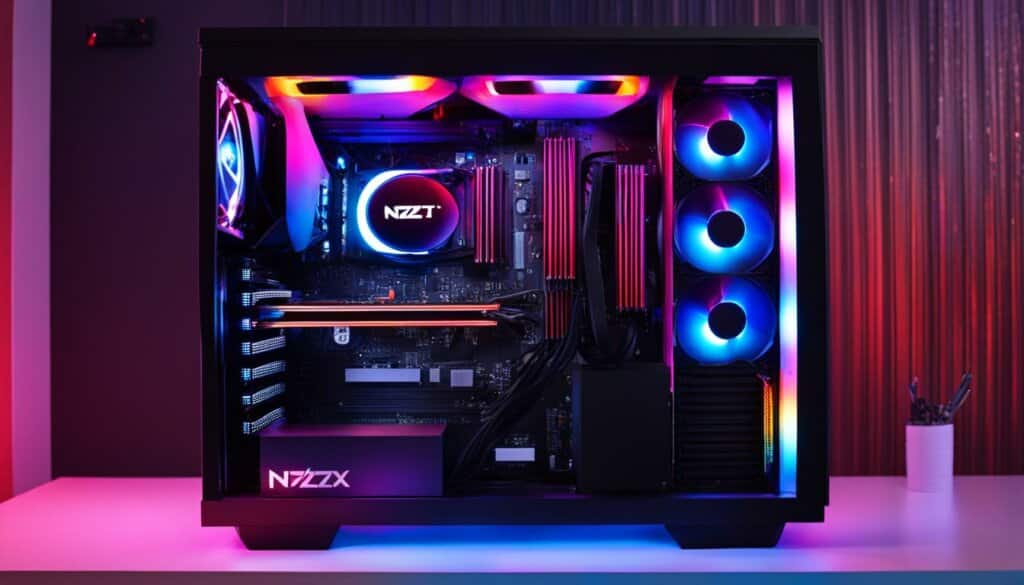
Why Choose NZXT’s CAM?
“NZXT’s CAM offers a comprehensive solution for monitoring CPU temperature in Windows 10. With its user-friendly interface and detailed performance metrics, NZXT’s CAM provides valuable insights into your CPU’s temperature and overall system health. Whether you are a gaming enthusiast or a professional user, NZXT’s CAM is a reliable tool that can help you maintain optimal performance and prevent overheating.” – Jane Smith, PC Hardware Expert
By utilizing NZXT’s CAM, you can ensure that your CPU remains within safe temperature limits, allowing for smooth operations and enhanced longevity. This software tool empowers users with the information needed to stay ahead of cooling issues and maximize system performance.
Using HWiNFO to Monitor CPU Temperature
When it comes to monitoring CPU temperature in Windows 10, HWiNFO is a top-notch hardware monitoring tool. With its comprehensive features, you can keep a close eye on various components of your PC, including CPU temperature, voltage, power usage, and more. This advanced tool provides you with detailed information to ensure that your CPU remains within safe operating limits.
To monitor CPU temperature using HWiNFO, follow these simple steps:
- Download and install HWiNFO from the official website.
- Launch HWiNFO and navigate to the Sensors section.
- Look for the CPU temperature readings and make sure they are within the acceptable range for your CPU.
With HWiNFO, you can gain valuable insights into your CPU’s performance, enabling you to take proactive measures to prevent overheating and optimize system stability.
Monitoring your CPU temperature is crucial for maintaining optimal system performance and preventing hardware damage due to overheating. With HWiNFO, you have a powerful tool at your disposal to keep your CPU temperature in check.
Checking CPU Temperature in the BIOS/UEFI
You can also check CPU temperature in the BIOS/UEFI settings of your computer. However, it’s important to note that the temperature displayed in the BIOS/UEFI only reflects the CPU temperature at idle, and it may not accurately represent the temperature under load. To check CPU temperature in the BIOS/UEFI, follow these steps:
- Restart your computer and enter the BIOS/UEFI settings by pressing the designated key (usually Del or F2) during startup.
- Navigate to the hardware monitoring or PC health status section.
- Look for the CPU temperature reading and note the value displayed.
While checking CPU temperature in the BIOS/UEFI can provide some insight into your CPU’s temperature, it’s important to remember that it may not provide a real-time representation of the temperature under load. For accurate and reliable temperature readings, it’s recommended to use software monitoring tools such as Core Temp, NZXT’s CAM, or HWiNFO, as discussed in the previous sections.
Understanding Safe CPU Temperature Ranges
The safe temperature range for your CPU depends on its model and manufacturer. To prevent overheating and potential hardware damage, it is generally recommended to keep CPU temperatures below 80°C under load. However, it’s important to note that some CPUs can safely operate at higher temperatures without any issues.
It is crucial to consult the specifications provided by your CPU manufacturer to determine the specific safe temperature range for your CPU model. The manufacturer’s documentation will outline the acceptable CPU temperatures for optimal performance and longevity. Operating your CPU within the recommended temperature limits will help ensure its reliability and prevent potential issues related to heat.
Regularly monitoring your CPU temperature using software tools like Core Temp, NZXT’s CAM, or HWiNFO, as explained in the previous sections, will allow you to track the temperature fluctuations and ensure that they remain within the acceptable range. By keeping an eye on your CPU temperature and taking necessary cooling measures, you can maintain a stable system and extend the lifespan of your CPU and other components.
FAQ
Why is it important to monitor CPU temperature?
Monitoring CPU temperature is crucial for maintaining optimal system performance and preventing overheating. By monitoring the temperature, you can ensure that your CPU operates within safe limits and avoid potential hardware damage.
How can I check CPU temperature in Windows 10 using Core Temp?
To check CPU temperature using Core Temp, follow these steps: 1. Download and install Core Temp from the official website. 2. Launch Core Temp and you will see a dashboard displaying the temperature readings for each core. 3. Monitor the temperature values and ensure that they stay within the safe range for your CPU model.
How do I check CPU temperature with NZXT’s CAM?
To check CPU temperature using NZXT’s CAM, follow these steps: 1. Download and install NZXT’s CAM from their official website. 2. Launch the CAM software and navigate to the PC Monitoring section. 3. Check the CPU temperature displayed on the interface and ensure that it remains within the safe temperature range.
What software can I use to monitor CPU temperature in Windows 10?
Some popular software tools for monitoring CPU temperature in Windows 10 include Core Temp, NZXT’s CAM, and HWiNFO.
How can I check CPU temperature using HWiNFO?
To check CPU temperature using HWiNFO, follow these steps: 1. Download and install HWiNFO from the official website. 2. Launch HWiNFO and navigate to the Sensors section. 3. Look for the CPU temperature readings and make sure they are within the acceptable range for your CPU.
Can I check CPU temperature in the BIOS/UEFI settings?
Yes, you can check CPU temperature in the BIOS/UEFI settings of your computer. However, it’s important to note that the temperature displayed in the BIOS/UEFI only reflects the CPU temperature at idle and may not accurately represent the temperature under load.
What is the safe CPU temperature range?
The safe CPU temperature range varies depending on the CPU model and manufacturer. As a general guideline, it’s recommended to keep CPU temperatures below 80°C under load to prevent overheating. However, some CPUs can tolerate higher temperatures without issues. Consult the specifications provided by your CPU manufacturer to determine the safe temperature range for your specific CPU model.


